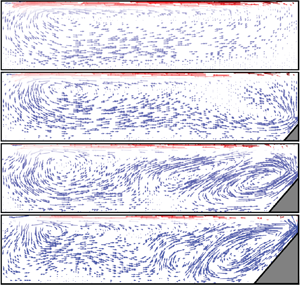No CrossRef data available.
Article contents
The effect of tidal force and topography on horizontal convection
Published online by Cambridge University Press: 09 December 2021
Abstract

We present a numerical study on how tidal force and topography influence flow dynamics, transport and mixing in horizontal convection. Our results show that local energy dissipation near topography will be enhanced when the tide is sufficiently strong. Such enhancement is related to the height of the topography and increases as the tidal frequency  $\omega$ decreases. The global dissipation is found to be less sensitive to the changes in
$\omega$ decreases. The global dissipation is found to be less sensitive to the changes in  $\omega$ when the latter becomes small and asymptotically approaches a constant value. We interpret the behaviour of the dissipation as a result of the competition among the dominant forces in the system. According to which mechanism prevails, the flow state of the system can be divided into three regimes, which are the buoyancy-, tide- and drag-control regimes. We show that the mixing efficiency
$\omega$ when the latter becomes small and asymptotically approaches a constant value. We interpret the behaviour of the dissipation as a result of the competition among the dominant forces in the system. According to which mechanism prevails, the flow state of the system can be divided into three regimes, which are the buoyancy-, tide- and drag-control regimes. We show that the mixing efficiency  $\eta$ for different tidal energy and topography height can be well described by a universal function
$\eta$ for different tidal energy and topography height can be well described by a universal function  $\eta \approx \eta _{HC}/(1+\mathcal {R})$, where
$\eta \approx \eta _{HC}/(1+\mathcal {R})$, where  $\eta _{HC}$ is the mixing efficiency in the absence of tide and
$\eta _{HC}$ is the mixing efficiency in the absence of tide and  $\mathcal {R}$ is the ratio between tidal and available potential energy inputs. With this, one can also determine the dominant mechanism at a certain ocean region. We further derive a power law relationship connecting the mixing coefficient and the tidal Reynolds number.
$\mathcal {R}$ is the ratio between tidal and available potential energy inputs. With this, one can also determine the dominant mechanism at a certain ocean region. We further derive a power law relationship connecting the mixing coefficient and the tidal Reynolds number.
- Type
- JFM Papers
- Information
- Copyright
- © The Author(s), 2021. Published by Cambridge University Press





